Surreal Songs Say So Much: Platonic Boyfriends
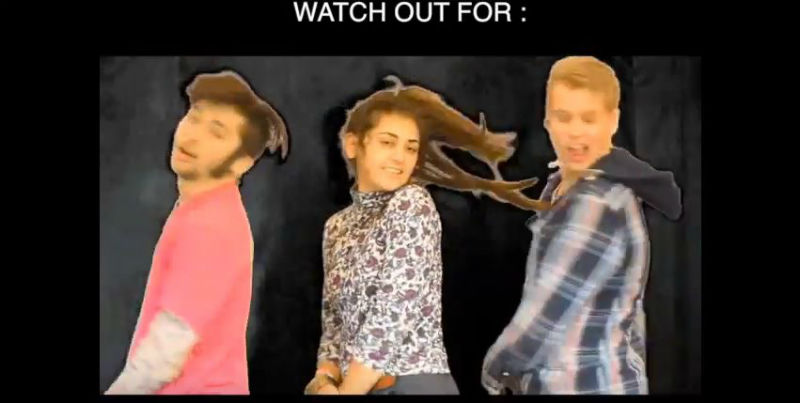
Have you ever heard a band and just been confused?
That's the effect Ann Arbor's Platonic Boyfriends had on me the first time I listened to the trio's debut album, Pee on These Hands.
That confusion stayed through the second listen. And the third. And it's continued unabated through subsequent spins. But I keep listening, and listening, and listening, which is a testament to Platonic Boyfriends' puzzling uniqueness.
Noor (bass), Klayton Dawson (guitar), and Isaac Levine (drums, lead vocals) create a kind of countrified, performance-art-inspired, lo-fi indie rock that is smart, surreal, funny, disjointed, and sui generis. My simple brain wants to put Platonic Boyfriends in a genre box for easy categorization, but Pee on These Hands doesn't allow it.
Platonic Boyfriends will celebrate the release of Pee on These Hands (CD, cassette, Bandcamp) with a record-release show on Friday, Jan. 26, at a secret location (that you can find on the band's Facebook page). I emailed with Ahmad and Levine about the band's origins, influences, and the serious message behind their song "Don't Move."
UMMA's smaller exhibitions still make a big impact
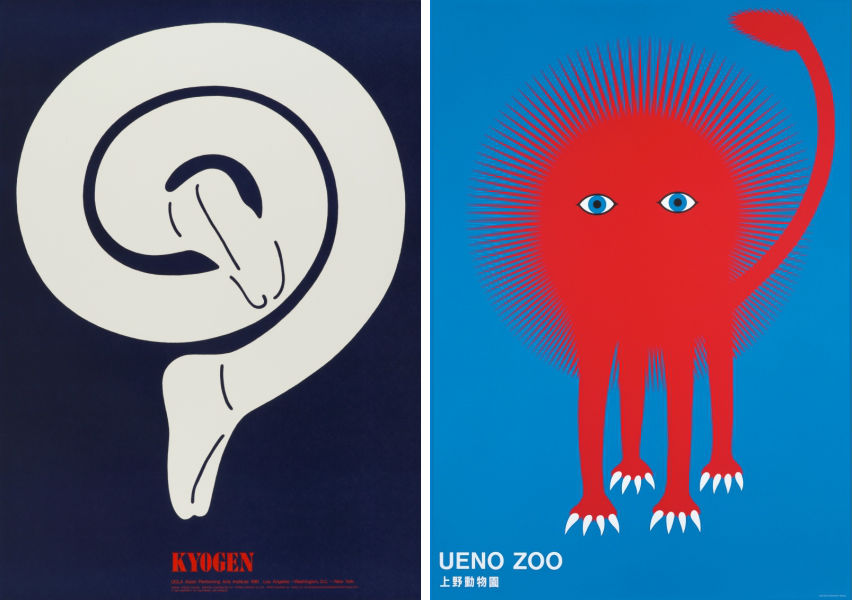
The main draw at the University of Michigan Museum of Art right now is Matisse Drawings: Curated by Ellsworth Kelly from The Pierre and Tana Matisse Foundation Collection.
And rightfully so since it features little-seen works by two masters. (John Cantu raved about the exhibition in his Pulp review.)
Meanwhile, Aftermath: Landscapes of Devastation is a breathtaking collection of "images of the aftermath of events spanning over 2,000 years of human history -- from ancient Pompeii to September 11, 2001."
But there are several other UMMA displays worth your time, even if there's not enough there there for a full review.
Here's a look at some of the smaller exhibits currently at UMMA.
Resistance Paintings: Juliet Seignious' "Over/Come(ing)" at AADL
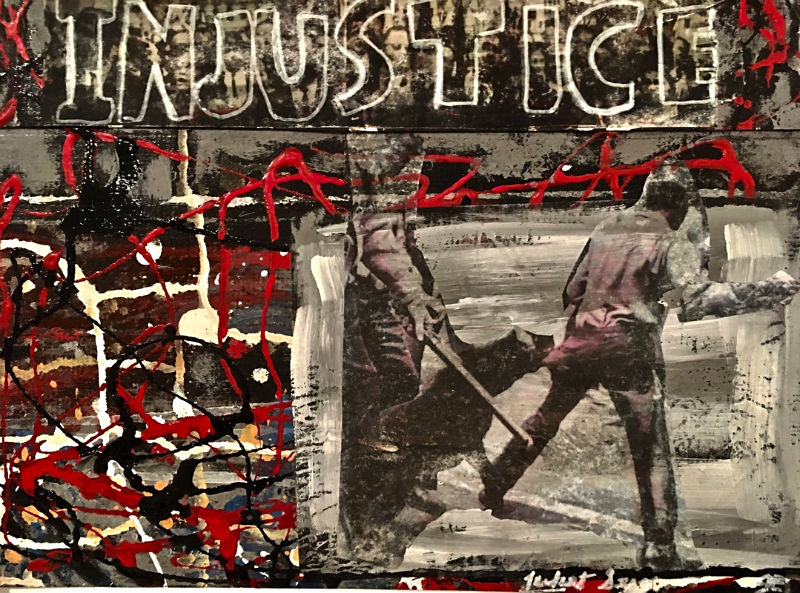
In 1958, Juliet Seignious was a founding member of the Alvin Ailey Dance Company. It was during her time in this groundbreaking modernist dance troupe that Seignious started to explore her African-American heritage, which stretched from the Harlem of her youth to her parents’ roots in Edisto Island, S.C., which was a frequent landing spot for slave ships and, eventually, the home of escaped former slaves.
Once her dance career was over, Seignious turned her attention to another form of artistic expression: painting. But her desire to delve into African-American history continued unabated. A 1990 exploratory visit to Edisto Island inspired Journeys, which is comprised of 15 brightly colored but mysterious acrylic paintings and one pastel drawing.
Remake, Remodel: The State Theatre rises once again

The March 17, 1942, edition of The Ann Arbor News was mental about the State. The paper’s entire second section was dedicated to the first movie theater to open in Ann Arbor since the Michigan Theater flung open its doors Jan. 5, 1928. “ABLAZE WITH RADIANT BEAUTY” trumpeted the all-caps headline above a glowing black-and-white photo of the State Theatre’s gorgeous marquee. At least 18 stories were published about the State (“New Local Theater Most Modern Found in Michigan”), its owners (“Butterfield Theaters, Inc. Now Operating 114 Houses”), and other film-related tales, including “Opening Of New Theater Revives Memories Here Of Student Riot In 1908,” which destroyed Ann Arbor’s original movie house, The Star. And the section was filled with congratulatory advertising, including one headlined “The New Pride of Ann Arbor,” purchased by the George W. Auch Co., the State Theatre’s general contractor, though 35 different firms worked on the build. That edition of the newspaper was a full-on love letter to the State Theatre, and The Michigan Daily was similarly smitten, dedicating six pages to movie-house-related stories. There’s akin ardor in today’s digital-media realm about the venerated movie house’s latest reinvention, which opens its doors to members on Friday, Dec. 8 and to the public on Saturday, Dec. 9.
Sonic Sculpture: Adam Shead's "Adiaphora Music," a master's recital
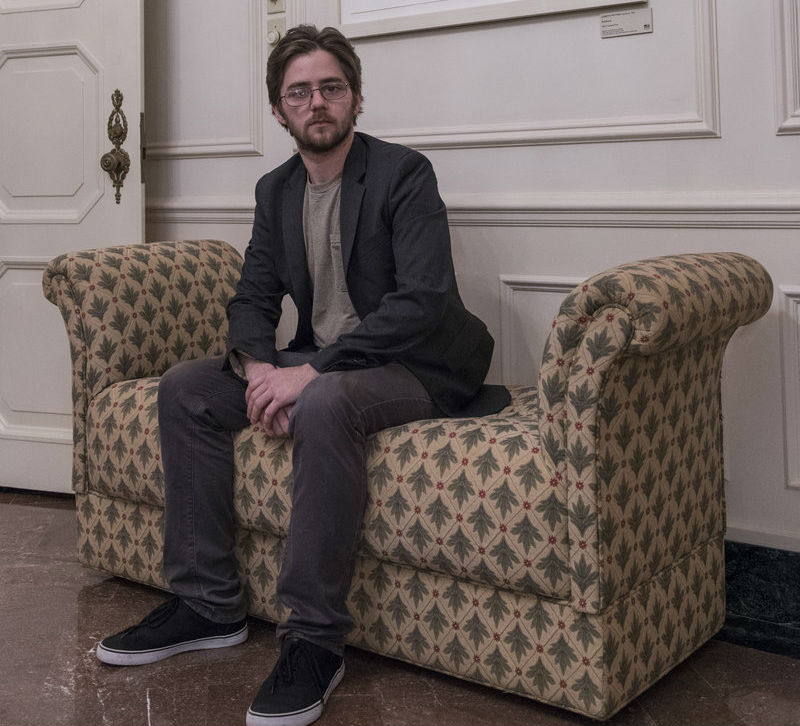
As someone with a bachelor's of music in percussion performance from Columbia College Chicago and, soon, a master's degree in improvisation from the University of Michigan, drummer Adam Shead sounds like an academic. But while growing up in South Bend, Indiana, it was hardcore punk that first informed Shead's attitude and artistic aesthetic. That combination of academic rigor and raw energy is what makes Shead's drumming such a potent force, which he'll get demonstrate live on Friday, Dec. 8, at U-M's Duderstadt Video Studio when he presents his master's recital, Adiaphora Music. The seven-part suite features 11 musicians along with Shead exploring his influences, which run from Chicago visionaries AACM, Ken Vandermark, and Tim Daisy to South Africa's Dudu Pukwana, and contemporary classical giants Morton Feldman and John Luther Adams to H.R., lead singer of the groundbreaking punk band Bad Brains. We talked to Shead about his philosophy, sound, and the meaning of Adiaphora Music.
Kick Out the Hams: Wild Savages' "Queen Bee" video
Do you remember the days before the smoking ban when you'd leave a concert smelling of stale cigarettes and cheap beer, and the stench would permeate your rusted-out car on the late-night ride home, lingering in your nose the next morning?
Wild Savages are the soundtrack for that drive.
The Ann Arbor trio plays bluesy proto-metal that would not have been out of place on WRIF in 1980. Think of Wild Savages as part of the 1970s Black Sabbath, Foghat, and Nazareth lineage that has produced contemporary bands like Red Fang, Saviours, and The Sword.
"Queen Bee" is the first single off the band's second album, Stagefright, which is being feted with a free record-release concert at The Blind Pig on Saturday, Dec. 16. Wild Savages goof around in the video by mugging for the camera like 1980s hair-metal bands, shotgunning beers, and playing bass on the toilet.
In other words, it's totally great.
All in the Family: Saxophonist Peter Formanek's senior recital
Peter Formanek is a 22-year-old saxophonist who is about to graduate from the University of Michigan's School of Music, Theatre & Dance with a Bachelor of Fine Arts degree.
But he's been studying music with a Ph.D.-level teacher his whole life.
His father, Michael Formanek, toured with giants like Tony Williams and Joe Henderson when he was still a teen in the early 1970s, and he went on to play with Freddie Hubbard, Gerry Mulligan, Stan Getz, Tim Berne, and Fred Hersch, among many others. He also records as a leader for ECM Records, one of the greatest jazz and classical labels ever.
As the younger Formanek mentioned at Love Songs, his senior recital on Monday, Nov. 27, at Kerrytown Concert House, there were always great musicians coming over to his family's home in Baltimore, Md. As he said while introducing his father, who joined him for the evening's final song, "I'm going to call up my dad, who is not only the person responsible for getting me into music but also giving me so many musical opportunities and access to all these really, really amazing musicians that I've been able to be around my entire life."
Formanek live-streamed his recital, which is archived on YouTube. (There will also be a high-quality edited version with audio from the board.) Below you'll find the list of musicians who joined him and the set list, which includes songs by Charles Mingus and Wayne Shorter, along with four Formanek originals -- three by Peter and the set closer by his dad.
Synthesize Your Life: A wrap-up of Mini MoogFest 2017
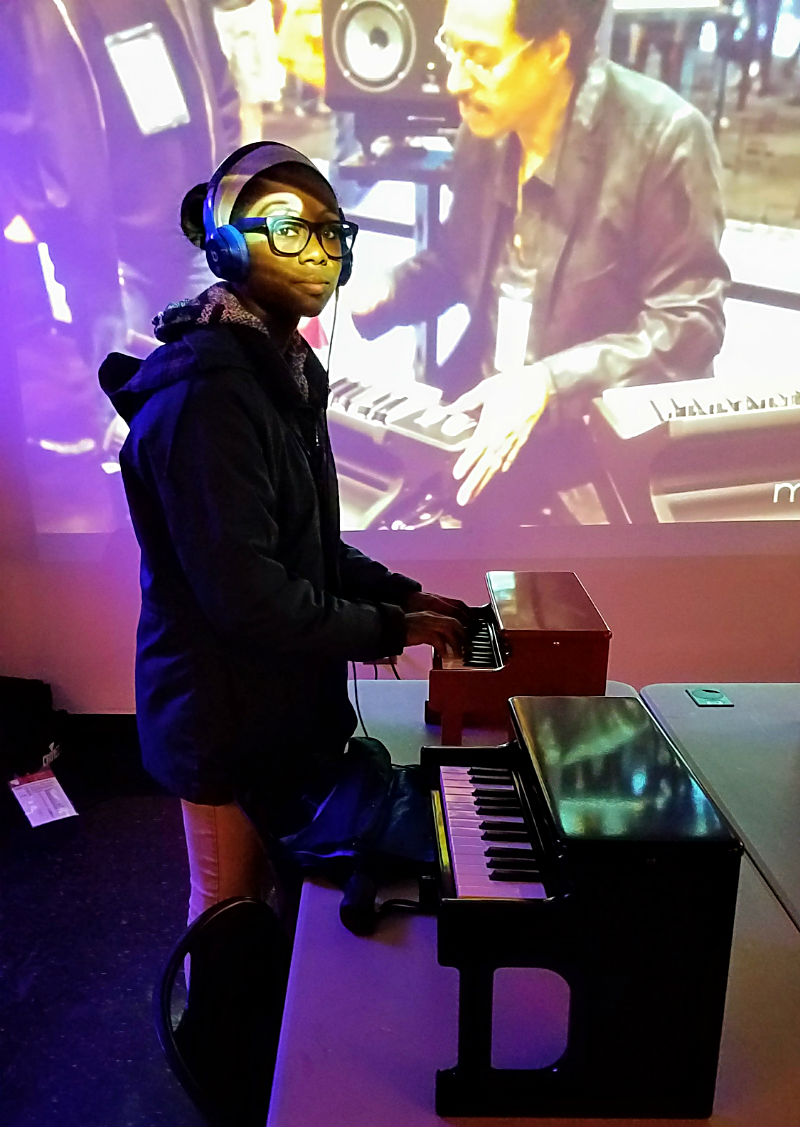
If we Ann Arbor District Library staffers were excited synthesizers, we'd be whooping with pitch-bent, major-key oscillations from the joy Mini MoogFest 2017 brought us. Our third annual iteration of this event greatly expanded upon our two previous offerings, and we had a fully packed house at the Downtown Library on Saturday, Nov. 18. Librarians on the scene estimated that over 350 people -- including around 75 kids -- made their way through Mini MoogFest, where they built synths using littleBits, played around with AADL's Music Tools, and enjoyed live performances from area electronica artists. Below is a roundup of photos, videos, and social media posts covering Mini MoogFest 2017.
Mini MoogFest 2017: Sound Science
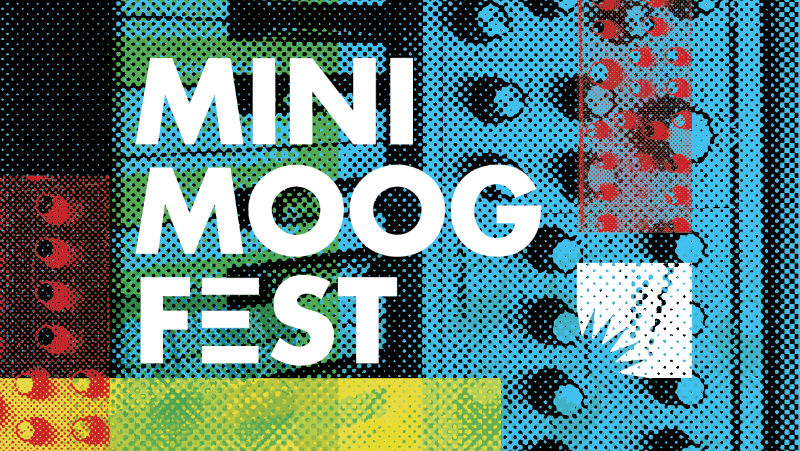
Robert Moog had no musical talent. But his talents changed music.
At the age of 15, Moog built his first Theremin, the ghostly, no-touch instrument created by Leon Theremin in the 1920s that used the amplitude and voltage of radio waves to manipulate two oscillators controlling pitch and volume. Moog continued to use his engineering skills to fine-tune these instruments, and by age 19 he was selling Theremin kits to help fund his college studies.
In 1964, the year before he earned his Ph.D. in engineering physics from Cornell University, Moog created his first synthesizer. By 1968, everyone from Stevie Wonder to The Beatles had used Moog synths on recordings, and in 1969 Wendy Carlos -- a frequent advisor to Moog -- had a chart-topping hit with Switched-On Bach, an LP featuring all-electronic versions of classical masterpieces.
By the early 1970s, the Minimoog Model D -- the world's first portable synthesizer -- became a staple in popular music and set the groundwork for all electronic music that followed, from the ambient bliss of Brian Eno and film soundtracks of Vangelis to the robotic beats of Kraftwerk and the entire genre of Detroit techno.
It's with Moog in mind that we created the Ann Arbor District Library's Mini MoogFest (Sat. Nov. 18, 12-4 pm, downtown branch). But it's a really a celebration of all the things that whoosh, squiggle, chirp, beep, bleep, and gurgle, from Don Buchla's equally important modular-synth inventions in the 1960s right up to today's home-brew makers who bust out the soldering irons and circuit boards to create their own custom sound modules.
At Mini MoogFest you'll be able to test out a variety of effects pedals, music-making software, and electronic instruments, including Moog modular units and Thereminis, the Arp Odyssey, and many more. Many of the pieces are available to borrow from AADL's Music Tools collection, too. Think of it as a music store where you won't get yelled at for playing around with the gear.
We'll also have three performances in the multipurpose room by artists who will talk about how they create their sounds, from the basics of synthesis to the specific gear in their stage setups. The lineup is:
➥ 1 pm: Sean Curtis Patrick (➲ PULP INTERVIEW), Kendal Babl, and Chuck Sipperley
➥ 2 pm: Mike Dykehouse (➲ PULP INTERVIEW)
➥ 3 pm: North Coast Modular Collective (➲ PULP INTERVIEW)
Producer, audio engineer, and artist Alex Taam -- who records under the name Mogi Grumbles -- will also be on hand to allow folks to play with his various Moogs and modulars as well as assist people in exploring the gear that will be spread around in the Secret Lab. (➲ PULP INTERVIEW)
This is a family-friendly event, too, so bring the kids and let them make outer-space sounds, video-game soundtracks, and noise jams. There will also be giveaways featuring T-shirts, winter hats, patch cables, screwdrivers, buttons, and other swag from gear companies and dealers such as Make Noise, Line 6, Boss, Roland, Korg, Electro-Fautus, Control, Perfect Circuit Audio, Reverb, and Sweetwater.
If you've ever been interested in how to make electronic music, Mini MoogFest is the perfect opportunity to dabble, experiment, and invent. As with Robert Moog, no musical talent is necessary.
Christopher Porter is a library technician and the editor of Pulp.
Mini MoogFest is Saturday, Nov. 18, 12-4 pm in the multipurpose room and Secret Lab of the Ann Arbor District Library's downtown branch, 343 S. 5th Ave. Facebook event page. Check out interviews with Mini MoogFest performers Sean Curtis Patrick, Alex Taam, North Coast Modular Collective, and Mike Dykehouse.
Mini MoogFest 2017: North Coast Modular Collective
The North Coast Modular Collective is like a modular synthesizer: made up of many parts to create a sonic whole. The group is a loose collection of Washtenaw County-area musicians and creators who teamed up earlier this year and pooled their talents to share gear, create new instruments, and trade ideas.
The trio of Joe Bauer, Dan Blades, and Bill Van Loo will represent the collective at Mini MoogFest, and we asked them their about plans for the event, the gear they'll be using, and their favorite synth-leaning recordings. (Also, here's a primer on Eurorack synths, which the collective mentions several times.)
Q: What's your plan for MoogFest?
NCMC: Three of us from North Coast Modular Collective will be there. In short, we’re a group of artists, academics, and makers who aim to spread curiosity, enable exploration, and foster community. Then each of us will spend 15 minutes doing some combination of talking and performing.
Bauer: I’ll be playing about 10 minutes of semi-improvised electro-glitch music (similar to this or this) and then I’ll spend about five minutes explaining and demonstrating a few of the basic concepts and techniques I used. If you’re curious about how I get ready for a show you can follow me on Instagram or YouTube to see some behind the scenes clips as I get prepared.
Blades: I’ll spend a couple of minutes talking about my latest modular build. I’ll then be using it as an audio source and running the audio through some Eurorack effects. The set will be completely improvisational.
Van Loo: I will be performing a rolling 10-minute exploration of deep dub techno chords and sounds, and then spend about 5 minutes explaining what I used and how I used it. Check out the chromedecay Instagram account for behind-the-scenes takes on how this has been developing, via grainy 60-second square videos.
Q: What's your gear setup?
Van Loo: Since we’re focusing on the modular aspect for this performance, I’ll be using a single row Eurorack system, with a mix of prototype North Coast Modular Collective modules, modules from other manufacturers, and DIY pieces. Most of the main sounds will come from this single set of modules, but I’ll add some drum sounds -- some created with a virtual modular synthesizer called VCV Rack -- sequenced on the Novation Circuit. Delay and reverb will allow me to create the atmosphere I want for my set.
Bauer: I’ll be using a 9U, 104hp self-built Eurorack case with 32 modules from 18 different manufacturers. Fourteen modules were self-built. Of those, four are North Coast Modular Collective designs. English translation: I have a wood box with a bunch of electronics in it -- some of them I built, a few I helped design -- and wires and knobs hanging out of it.
This is what it looks like without any of the wires plugged in:
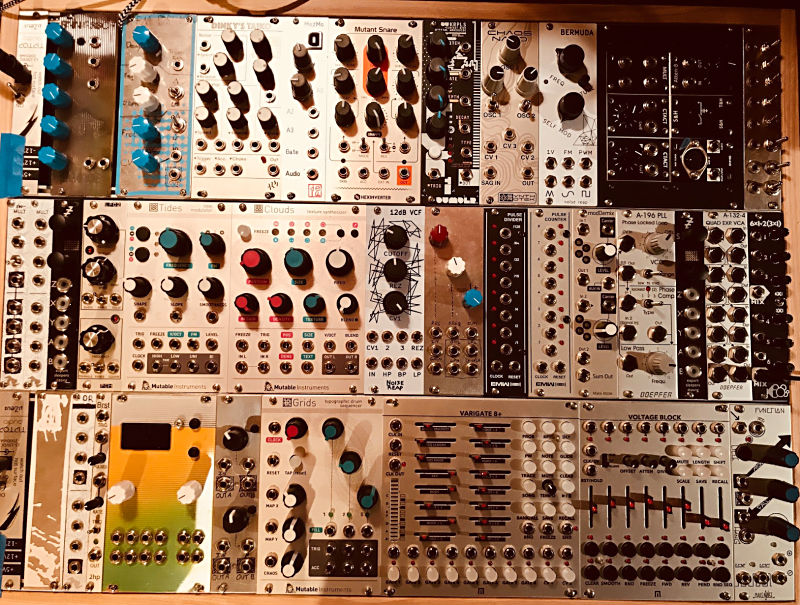
Blades: My main setup is mostly Eurorack. It’s my vessel to explore sound design. It’s constantly changing and evolving. Lately, I’ve favored modules that work well in live situations, modules that can sample audio, and modules that produce random voltages. I want my setup to surprise me and anyone who wants to listen.
This is my latest completed project that I will be using for my performance:
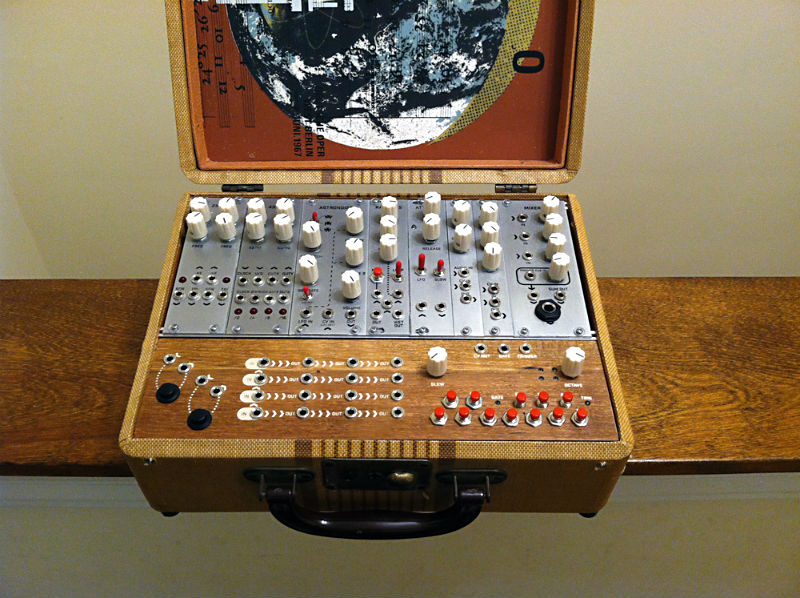
The idea behind this project was to build a flexible, self-contained, portable synth that had the capability of being used as a “traditional” monosynth but could also be an experimental sound platform. The synth is made up of 10 Eurorack modules, built from available manufactured PCB boards, installed into a repurposed vintage suitcase.
NCMC: North Coast Modular Collective tries to spread curiosity, enable exploration, and foster community. To that end, we held a three-day camp over summer where we designed and built our own set of modular synthesizer cases. During that time we also built and programmed a few modules from a popular module designer who goes by the name of mxmxmx.
Our design process often includes cardboard mockups of early concepts to make sure the design concept basics work in physical form. From there we commonly break up circuits into isolated building blocks and use several iterations of design/build/test for each design block before integrating them together into a single module.
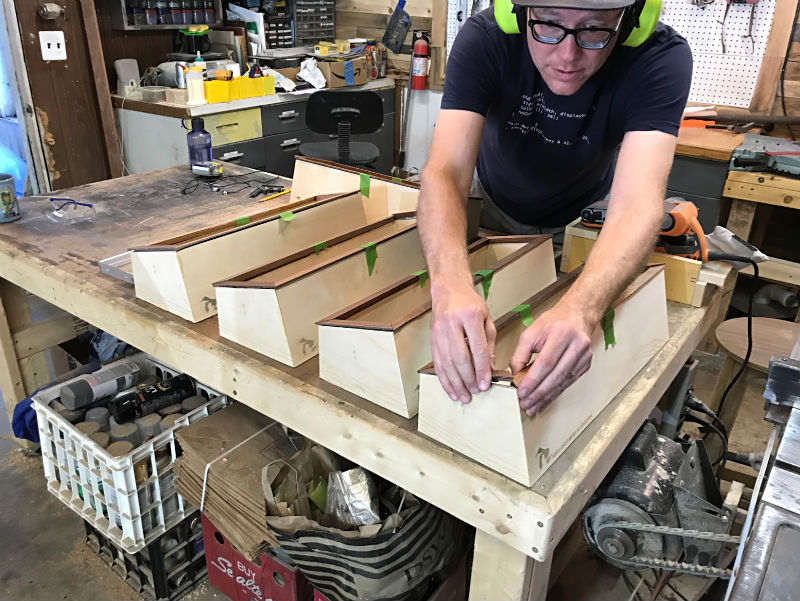
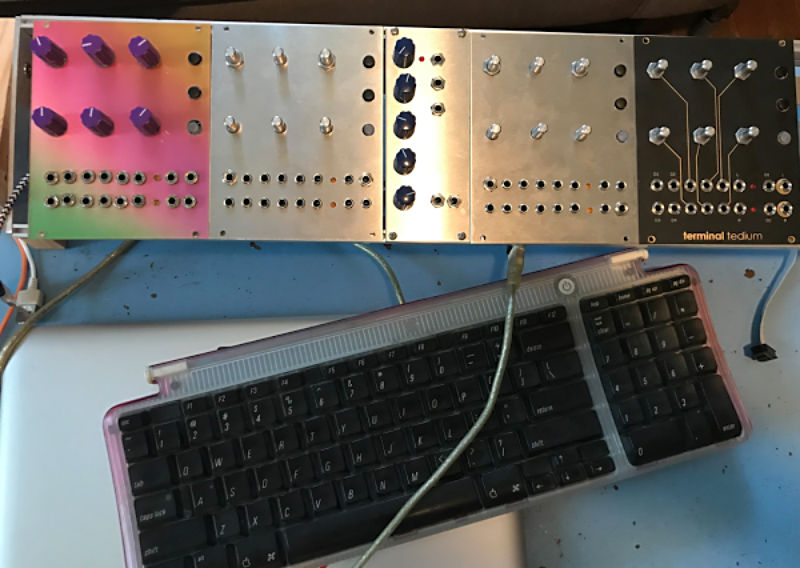
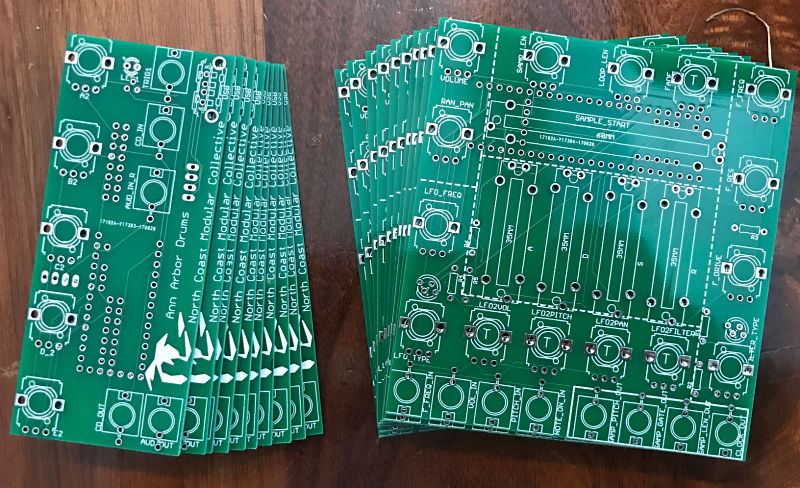
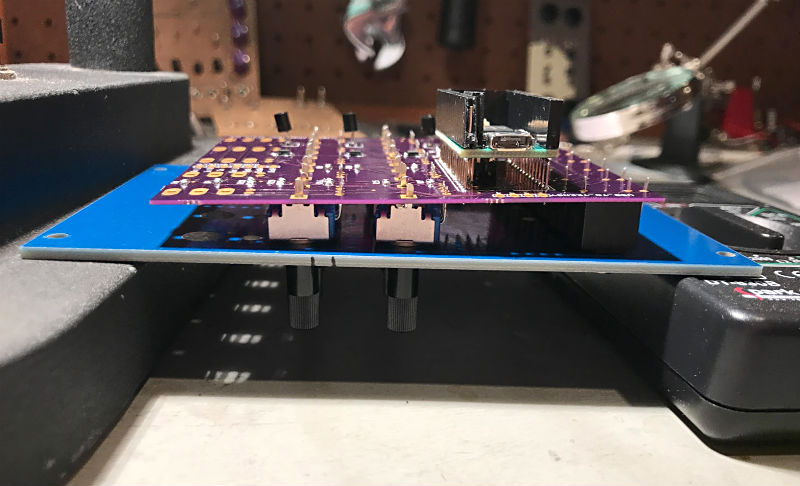
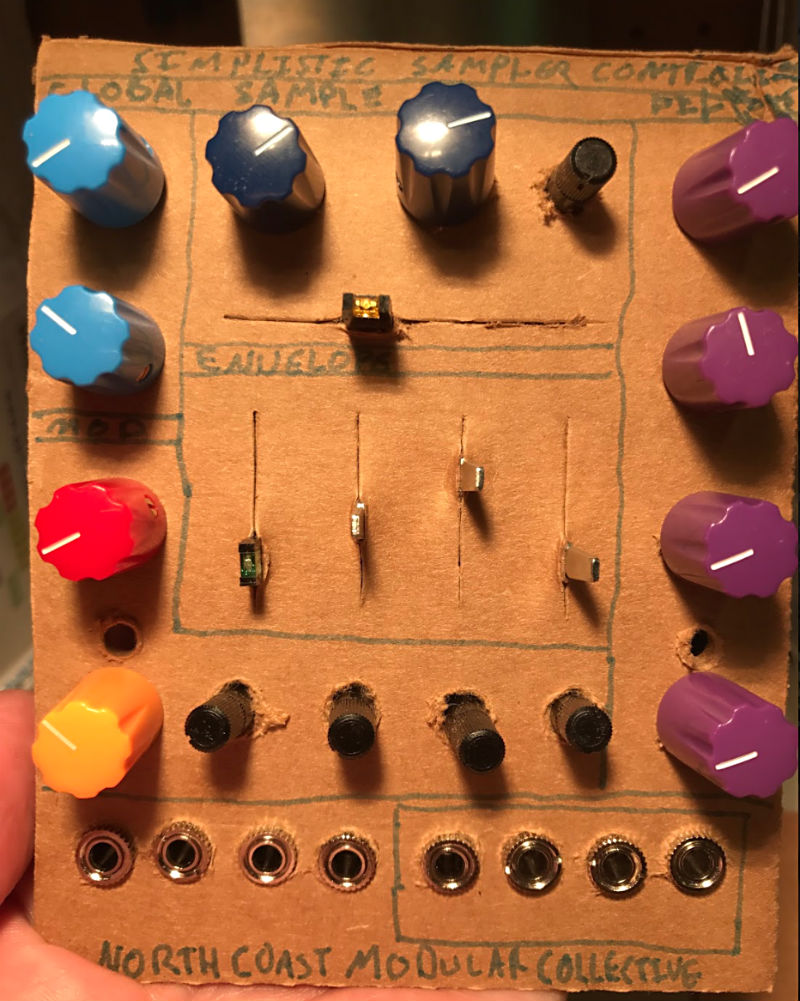
Q: Name some synth-related records that you'd recommend to newbies.
Bauer: It’s not a record, but I highly recommend watching:
➥ I Dream of Wires (AADL link). It’s a great introduction to the history of synthesis and does a nice job of putting some context around Bob Moog and Don Buchla and how their work still impacts music today.
Blades: One of my favorite artists:
➥ Venetian Snares, Traditional Synthesizer Music: A full album of live modular music created by Aaron Funk. Here is a video of Aaron with his modular performing a track from the album:
Van Loo: Here are a few records that have inspired me and are well worth digging into:
➥ Kraftwerk, Computer World: A perfect combination of pop sensibility with the most pure electronic sounds. Utterly classic.
➥ Monolake, Hong Kong: A deep slice of Berlin-based dub techno, using found sounds, synthesis, and echoes to set an amazing atmosphere. The duo went on to found Ableton, the company that makes Ableton Live, perhaps the most important piece of music software in the past 15 years.
➥ Telefon Tel Aviv, Fahrenheit Fair Enough: Impeccable sound design and programming. Still an inspiration 15 years after its release.
➥ Psyche/BFC, Elements 1989-90: Classic Detroit techno from one of my favorite Carl Craig aliases. “How the West Was Won” from this record may be one of the loveliest and most gently melancholic pieces of electronic music that exists.
➥ Steve Reich, Music for 18 Musicians: Not truly electronic at all, but so deeply influential to how I approach electronic music as to be essential, and Reich’s early tape and electronics work predates much of the current interest in things like Euclidean rhythm, field recording, and phasing.
Christopher Porter is a library technician and the editor of Pulp.
Mini MoogFest is Saturday, Nov. 18, 12-4 pm in the multipurpose room and Secret Lab of the Ann Arbor District Library's downtown branch, 343 S. 5th Ave. Facebook event page. Read our introduction to MoogFest here. Check out interviews with Mini MoogFest performers Mike Dykehouse, Sean Curtis Patrick, and Alex Taam.


































